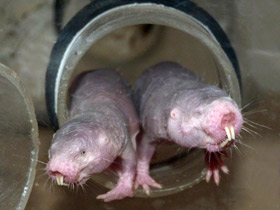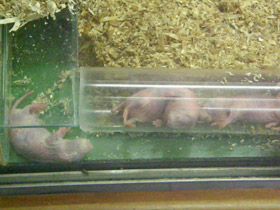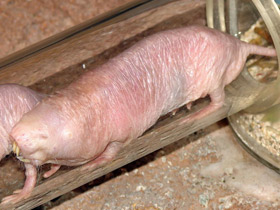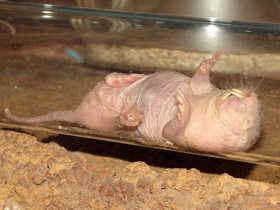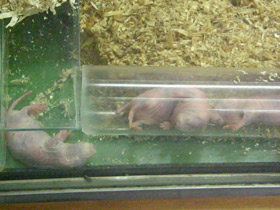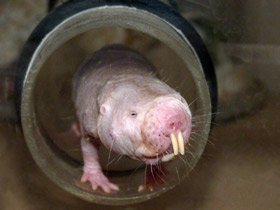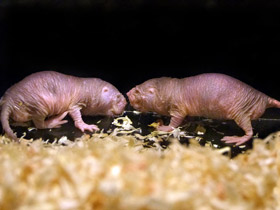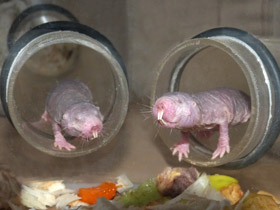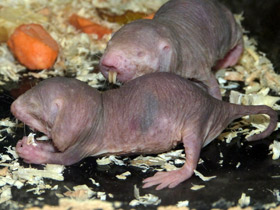Family mole rats Bathyergidae
The naked mole rat Heterocephalus glaber
These unique rodents live in dry savannahs and semi-deserts in Kenya, Ethiopia, and Somalia. The appearance of the naked mole rat reflects its adaptations to subterranean lifestyle. And indeed, these animals are rarely seen over the ground. The naked mole rat has a relatively round head sitting on short neck; the eyes are quite small (0.5 mm) and visual acuity is poor. Naked mole rats do not have external ears but their sense of hearing is very acute and they use a wide vocal repertoire, producing about 20 different vocalization types (no other rodents produce so many sounds). Besides, naked mole rats have highly developed senses of touch and smell; many sensory hairs cover the body and vibrissae are prominent around the snout, making it possible for these animals to move in the tunnels either heads or tails foremost. Naked mole rats are very small rodents: their body length ranges between 8 and 10 cm, the length of the tail is 3-4 cm and the weight of the males varies from 30 to 35 grams. Females are larger than males: they weigh 50 to 80 grams. Naked mole rats have little hair (hence the common name) and wrinkled pink or yellowish skin. Dense tufts of fine hairs grow only between the toes of the feet, which helps digging soil. The legs of the naked mole rats are thin and short. Their large protruding teeth are used to dig and their lips are sealed just behind the teeth, preventing soil from filling their mouths while digging. The mass of their jaw muscles comprises nearly 25% of the mass of all body muscles.
These secretive digging rodents feed on underground parts of plants such as lush roots, bulbs, and tubers (captive naked mole rats eat a wide variety of fruit and vegetables). Naked mole rats collect and store food in their underground feeding chambers. They live in colonies ranging from 70 to 80 animals (there were reports about the colony comprising 295 naked mole rats). The total length of the tunnels occupied by one colony may reach 3 to 5 km and the colony may eject 3 to 4 tons of soil annually. Typical diameter of the tunnel is 4 cm; the tunnels that are built at the depth of two meters connect nesting chambers with feeding and toilet chambers. When building new tunnels, naked mole rats work “in a team”: they usually expand the tunnels after rain periods when soil gets softer. Several individuals line up, with one naked mole rat in the front digging hard soil with incisors, while the other mole rats push the dirt down the line of 5 to 6 animals. Naked mole rats working in front of the line are regularly replaced by the animals working in the rare of the line.
Most interesting and unique characteristic of the naked mole rats is their complex social structure, typical for this species. Naked mole rats are eusocial animals which have advanced social structure similar to that of social insects. All individuals living in the colony are related to each other; dispersal is a rare event. The animals are highly inbred and members of the same colony are extremely genetically uniform. The colony has a specific job for each member and is led by the “queen”. Only a small group of fertile males (2-3 animals) is allowed to mate with the queen. The other naked mole rats in the colony, both males and females, serve as soldiers or workers. Physiologically, they are capable of breeding but do not have a right to participate in mating while staying in the colony. If the queen dies or is removed from the colony, several working females will fight, even to death, for the right to be a queen. Once a queen is established, she actually stretches the space between the vertebrae in her spine to become larger. Working functions of non-breeding animals strongly correlate with their body weights. Small individuals maintain the tunnel system, care for the queen’s pups, and scout for food. The largest, sterile animals serve as soldiers, possibly protecting the colony from its main enemies, snakes. During most part of the year these mole rats do just about 5% of all work (while their proportion in the colony reaches 25-40%). After rain season, they actively expand the net of the tunnels and partially disperse, establishing new colonies. Behavioural patterns of the workers of medium sizes have intermediate character. An individual’s social status is not fixed once individual attains adulthood and in contrast with ants, the naked mole rat “castes” are not clearly defined.
The naked mole rat queen is reproductively active all year round; she gives birth to 4 to 5 litters per year and produces hundreds of pups during her life (about 900 pups in 12 years were documented in one case). Gestation lasts 70 days. The queen is able to breed every 80 days. The newborn naked mole rat weighs less than two grams. Average size of the litter is larger than in other rodents of the same sizes: there are 12 to 27 pups in one litter (highest number for mammals) though the female has only six pairs of nipples. The study conducted by the scientists from the Cornell University demonstrated that the female naked mole rat produces plenty of milk and the young take turn nursing from the same mammary gland. It means that basic social behaviours are formed in the pups at the early stages of development. The queen nurses the pups for the first four weeks but the young start eating solid food as early as at the age of two weeks. Pups also eat faeces excreted by the worker naked mole rats; in this way, the young obtain bacterial flora necessary for digesting plant food. Young animals start working at the age of 3 to 4 weeks. They reach sexual maturity by the age of one year.
Naked mole rats have some other unique features. Thus, they are not able to regulate their body temperature in typical mammalian fashion and their body temperature depends on the ambient temperature. To slow down the loss of body heat, naked mole rats huddle together or bask in the shallow, more sun-warmed parts of their burrow systems. Reduced metabolic rate (two times lower than in other rodents) allows the naked mole rat to survive in underground tunnels with limited availability of oxygen and high levels of carbon dioxide. There is more about naked mole rats: they turned out to be completely impervious to the excruciating pain of the acid burn, even when the pH of the substance is below 3.5; neither are they sensitive to capsaicin, an active component of chilli peppers, that produces a sensation of burning in any tissue with which it comes into contact. American scientists have shown that naked mole rats naturally lack substance P in cutaneous C-fibres, that are responsible for the transmission of pain impulses to the central nervous system, and therefore these animals do not feel pain caused by burns or cuts.
The naked mole rat has extraordinary long longevity for a rodent of its size: these animals lived for up to 26 years in captivity. Queens usually live 13 to 18 years. Mechanisms responsible for such long life are still unknown. Researchers from the Tel Aviv University and the University of Texas suggest that the naked mole rat’s long life could be related to unusually high levels of NRG-1, a neuroprotecting protein which preserves high activity, bone health, and cognitive ability throughout lifespan.
Another interesting fact about naked mole rats is that these rodents appear to have a high resistance to tumours; cancer has never been observed in the animals of this species. Scientists discovered two mechanisms of the inhibition of the growth of tumour cells in the naked mole rat. Probably, the unique longevity of these animals is related to their resistance to cancer.

















